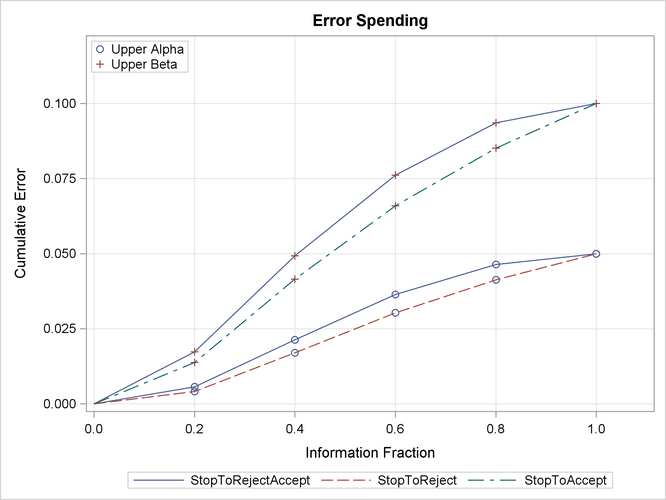The SEQDESIGN Procedure
-
Overview

- Getting Started
-
Syntax

-
Details
 Fixed-Sample Clinical TrialsOne-Sided Fixed-Sample Tests in Clinical TrialsTwo-Sided Fixed-Sample Tests in Clinical TrialsGroup Sequential MethodsStatistical Assumptions for Group Sequential DesignsBoundary ScalesBoundary VariablesType I and Type II ErrorsUnified Family MethodsHaybittle-Peto MethodWhitehead MethodsError Spending MethodsAcceptance (beta) BoundaryBoundary Adjustments for Overlapping Lower and Upper beta BoundariesSpecified and Derived ParametersApplicable Boundary KeysSample Size ComputationApplicable One-Sample Tests and Sample Size ComputationApplicable Two-Sample Tests and Sample Size ComputationApplicable Regression Parameter Tests and Sample Size ComputationAspects of Group Sequential DesignsSummary of Methods in Group Sequential DesignsTable OutputODS Table NamesGraphics OutputODS Graphics
Fixed-Sample Clinical TrialsOne-Sided Fixed-Sample Tests in Clinical TrialsTwo-Sided Fixed-Sample Tests in Clinical TrialsGroup Sequential MethodsStatistical Assumptions for Group Sequential DesignsBoundary ScalesBoundary VariablesType I and Type II ErrorsUnified Family MethodsHaybittle-Peto MethodWhitehead MethodsError Spending MethodsAcceptance (beta) BoundaryBoundary Adjustments for Overlapping Lower and Upper beta BoundariesSpecified and Derived ParametersApplicable Boundary KeysSample Size ComputationApplicable One-Sample Tests and Sample Size ComputationApplicable Two-Sample Tests and Sample Size ComputationApplicable Regression Parameter Tests and Sample Size ComputationAspects of Group Sequential DesignsSummary of Methods in Group Sequential DesignsTable OutputODS Table NamesGraphics OutputODS Graphics -
Examples
 Creating Fixed-Sample DesignsCreating a One-Sided O’Brien-Fleming DesignCreating Two-Sided Pocock and O’Brien-Fleming DesignsGenerating Graphics Display for Sequential DesignsCreating Designs Using Haybittle-Peto MethodsCreating Designs with Various Stopping CriteriaCreating Whitehead’s Triangular DesignsCreating a One-Sided Error Spending DesignCreating Designs with Various Number of StagesCreating Two-Sided Error Spending Designs with and without Overlapping Lower and Upper beta BoundariesCreating a Two-Sided Asymmetric Error Spending Design with Early Stopping to Reject H0Creating a Two-Sided Asymmetric Error Spending Design with Early Stopping to Reject or Accept H0Creating a Design with a Nonbinding Beta BoundaryComputing Sample Size for Survival Data That Have Uniform AccrualComputing Sample Size for Survival Data with Truncated Exponential Accrual
Creating Fixed-Sample DesignsCreating a One-Sided O’Brien-Fleming DesignCreating Two-Sided Pocock and O’Brien-Fleming DesignsGenerating Graphics Display for Sequential DesignsCreating Designs Using Haybittle-Peto MethodsCreating Designs with Various Stopping CriteriaCreating Whitehead’s Triangular DesignsCreating a One-Sided Error Spending DesignCreating Designs with Various Number of StagesCreating Two-Sided Error Spending Designs with and without Overlapping Lower and Upper beta BoundariesCreating a Two-Sided Asymmetric Error Spending Design with Early Stopping to Reject H0Creating a Two-Sided Asymmetric Error Spending Design with Early Stopping to Reject or Accept H0Creating a Design with a Nonbinding Beta BoundaryComputing Sample Size for Survival Data That Have Uniform AccrualComputing Sample Size for Survival Data with Truncated Exponential Accrual - References
Example 101.6 Creating Designs with Various Stopping Criteria
This example requests three 5-stage group sequential designs for normally distributed statistics. Each design uses a triangular
method with the specified one-sided upper alternative reference  . The resulting boundary values are displayed with the score scale. Note that these unified family triangular designs are
different from Whitehead’s triangular designs.
. The resulting boundary values are displayed with the score scale. Note that these unified family triangular designs are
different from Whitehead’s triangular designs.
The following statements request three designs with different stopping criterion:
ods graphics on;
proc seqdesign altref=0.2
bscale=score
errspend
plots=(combinedboundary errspend(hscale=info))
;
StopToRejectAccept: design nstages=5 method=tri alt=upper stop=both;
StopToReject: design nstages=5 method=tri alt=upper stop=reject;
StopToAccept: design nstages=5 method=tri alt=upper stop=accept;
run;
The first design has early stopping to reject or accept the null hypothesis  .
.
The "Design Information" table in Output 101.6.1 displays design specifications and derived statistics. With the specified alternative reference, the maximum information is derived.
Output 101.6.1: Triangular Design Information
| Design Information | |
|---|---|
| Statistic Distribution | Normal |
| Boundary Scale | Score |
| Alternative Hypothesis | Upper |
| Early Stop | Accept/Reject Null |
| Method | Triangular |
| Boundary Key | Both |
| Alternative Reference | 0.2 |
| Number of Stages | 5 |
| Alpha | 0.05 |
| Beta | 0.1 |
| Power | 0.9 |
| Max Information (Percent of Fixed Sample) | 140.0293 |
| Max Information | 299.797 |
| Null Ref ASN (Percent of Fixed Sample) | 59.11973 |
| Alt Ref ASN (Percent of Fixed Sample) | 66.94909 |
The "Method Information" table in Output 101.6.2 displays the  and
and  errors and the derived drift parameter, which is the standardized alternative reference at the final stage. The table also
shows the corresponding parameters for a triangular method as a unified family method.
errors and the derived drift parameter, which is the standardized alternative reference at the final stage. The table also
shows the corresponding parameters for a triangular method as a unified family method.
Output 101.6.2: Method Information
The "Boundary Information" table in Output 101.6.3 displays information level, alternative reference, and boundary values. With the specified BOUNDARYSCALE=SCORE option, the
alternative reference and boundary values are displayed in the score statistic scale. With a score scale, the alternative
reference is  , where
, where  is the specified alternative reference and
is the specified alternative reference and  is the information level at stage k,
is the information level at stage k,  .
.
Output 101.6.3: Boundary Information
| Boundary Information (Score Scale) Null Reference = 0 |
|||||
|---|---|---|---|---|---|
| _Stage_ | Alternative | Boundary Values | |||
| Information Level | Reference | Upper | |||
| Proportion | Actual | Upper | Beta | Alpha | |
| 1 | 0.2000 | 59.9594 | 11.99188 | -4.37102 | 19.61274 |
| 2 | 0.4000 | 119.9188 | 23.98376 | 4.89371 | 22.88154 |
| 3 | 0.6000 | 179.8782 | 35.97564 | 14.15845 | 26.15033 |
| 4 | 0.8000 | 239.8376 | 47.96752 | 23.42318 | 29.41912 |
| 5 | 1.0000 | 299.797 | 59.95940 | 32.68791 | 32.68791 |
The "Error Spending Information" table in Output 101.6.4 displays cumulative error spending at each stage for each boundary.
Output 101.6.4: Error Spending Information
With ODS Graphics enabled, a detailed boundary plot with the rejection and acceptance regions is displayed, as shown in Output 101.6.5. With the STOP=BOTH option, both the acceptance and rejection boundaries at interim stages are displayed. With the score scale, the acceptance and rejection boundaries are straight lines and form a triangular-shape continuation region.
Output 101.6.5: Boundary Plot with Score Statistics
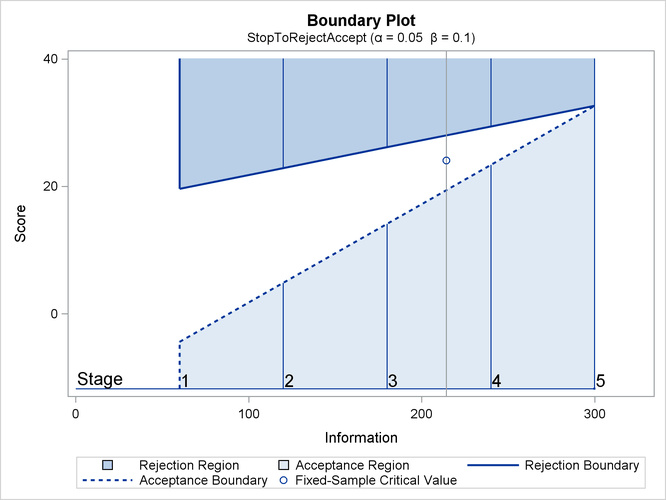
The second design has early stopping only to reject the null hypothesis  .
.
The "Design Information" table in Output 101.6.6 displays design specifications and derived statistics. With the specified alternative reference, the maximum information is derived.
Output 101.6.6: Triangular Design Information
| Design Information | |
|---|---|
| Statistic Distribution | Normal |
| Boundary Scale | Score |
| Alternative Hypothesis | Upper |
| Early Stop | Reject Null |
| Method | Triangular |
| Boundary Key | Both |
| Alternative Reference | 0.2 |
| Number of Stages | 5 |
| Alpha | 0.05 |
| Beta | 0.1 |
| Power | 0.9 |
| Max Information (Percent of Fixed Sample) | 113.4443 |
| Max Information | 242.8799 |
| Null Ref ASN (Percent of Fixed Sample) | 111.3399 |
| Alt Ref ASN (Percent of Fixed Sample) | 67.41968 |
The "Method Information" table in Output 101.6.7 displays the  and
and  errors and the derived drift parameter. The table also shows the corresponding parameters for a triangular method as a unified
family method.
errors and the derived drift parameter. The table also shows the corresponding parameters for a triangular method as a unified
family method.
Output 101.6.7: Method Information
The "Boundary Information" table in Output 101.6.8 displays information level, alternative reference, and boundary values. With the specified BOUNDARYSCALE=SCORE option, the alternative reference and boundary values are displayed in the score statistic scale.
Output 101.6.8: Boundary Information
| Boundary Information (Score Scale) Null Reference = 0 |
||||
|---|---|---|---|---|
| _Stage_ | Alternative | Boundary Values | ||
| Information Level | Reference | Upper | ||
| Proportion | Actual | Upper | Alpha | |
| 1 | 0.2000 | 48.57597 | 9.71519 | 18.38919 |
| 2 | 0.4000 | 97.15194 | 19.43039 | 21.45405 |
| 3 | 0.6000 | 145.7279 | 29.14558 | 24.51891 |
| 4 | 0.8000 | 194.3039 | 38.86078 | 27.58378 |
| 5 | 1.0000 | 242.8799 | 48.57597 | 30.64864 |
The "Error Spending Information" table in Output 101.6.9 displays cumulative error spending at each stage for each boundary.
Output 101.6.9: Error Spending Information
With ODS Graphics enabled, a detailed boundary plot with the rejection and acceptance regions is displayed, as shown in Output 101.6.10. For a triangular design, these rejection boundaries form a straight line with the score scale.
Output 101.6.10: Boundary Plot with Score Statistics
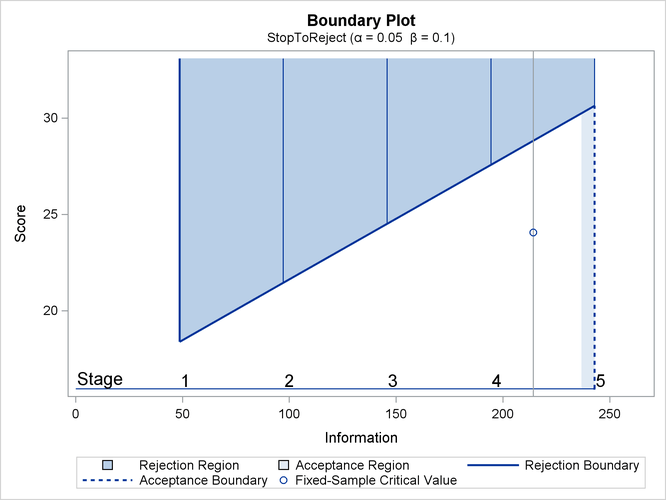
The third design has early stopping to accept the null hypothesis  .
.
The "Design Information" table in Output 101.6.11 displays design specifications and derived statistics. With the specified alternative reference, the maximum information is derived.
Output 101.6.11: Triangular Design Information
| Design Information | |
|---|---|
| Statistic Distribution | Normal |
| Boundary Scale | Score |
| Alternative Hypothesis | Upper |
| Early Stop | Accept Null |
| Method | Triangular |
| Boundary Key | Both |
| Alternative Reference | 0.2 |
| Number of Stages | 5 |
| Alpha | 0.05 |
| Beta | 0.1 |
| Power | 0.9 |
| Max Information (Percent of Fixed Sample) | 114.9925 |
| Max Information | 246.1945 |
| Null Ref ASN (Percent of Fixed Sample) | 57.83208 |
| Alt Ref ASN (Percent of Fixed Sample) | 110.2477 |
The "Method Information" table in Output 101.6.12 displays the  and
and  errors and the derived drift parameter. The table also shows the corresponding parameters for a triangular method as a unified
family method.
errors and the derived drift parameter. The table also shows the corresponding parameters for a triangular method as a unified
family method.
Output 101.6.12: Method Information
The "Boundary Information" table in Output 101.6.13 displays information level, alternative reference, and boundary values. With the specified BOUNDARYSCALE=SCORE option, the alternative reference and boundary values are displayed in the score statistic scale.
Output 101.6.13: Boundary Information
| Boundary Information (Score Scale) Null Reference = 0 |
||||
|---|---|---|---|---|
| _Stage_ | Alternative | Boundary Values | ||
| Information Level | Reference | Upper | ||
| Proportion | Actual | Upper | Beta | |
| 1 | 0.2000 | 49.2389 | 9.84778 | -5.62074 |
| 2 | 0.4000 | 98.4778 | 19.69556 | 1.64895 |
| 3 | 0.6000 | 147.7167 | 29.54334 | 8.91865 |
| 4 | 0.8000 | 196.9556 | 39.39112 | 16.18834 |
| 5 | 1.0000 | 246.1945 | 49.23890 | 23.45803 |
The "Error Spending Information" table in Output 101.6.14 displays cumulative error spending at each stage for each boundary.
Output 101.6.14: Error Spending Information
With ODS Graphics enabled, a detailed boundary plot with the rejection and acceptance regions is displayed, as shown in Output 101.6.15. For a triangular design, these rejection boundaries form a straight line with the score scale.
Output 101.6.15: Boundary Plot with Score Scale
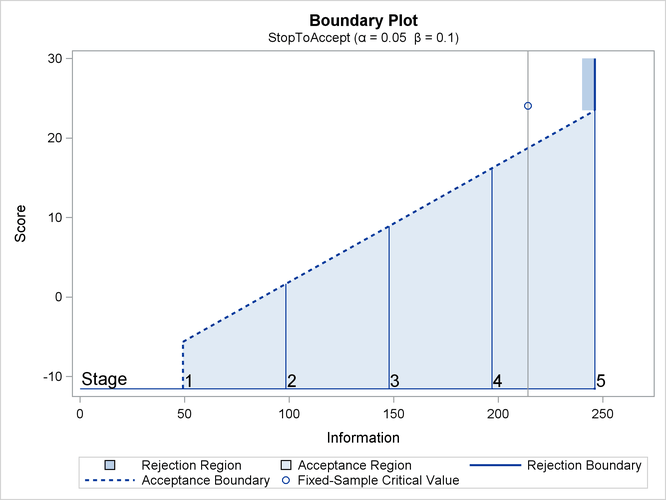
With the PLOTS=COMBINEDBOUNDARY option, a plot of the resulting sequential boundaries for all designs is displayed, as shown
in Output 101.6.16. The plot shows that the design with early stopping to reject and to accept  has larger maximum information than the other two designs.
has larger maximum information than the other two designs.
Output 101.6.16: Combined Boundary Plot with Score Scale
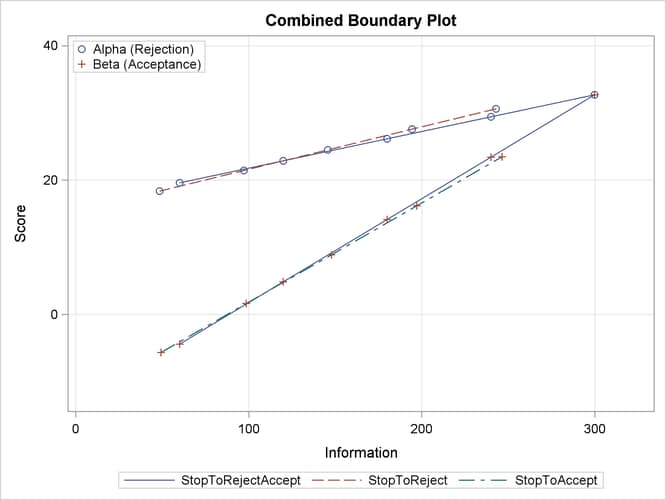
With the PLOTS=ERRSPEND(HSCALE=INFO) option, the error spending plot is displayed with the information level on the horizontal
axis, as shown in Output 101.6.17. The design with early stopping to reject or accept the null hypothesis  has larger
has larger  spending and larger
spending and larger  spending in early stages than the other two designs.
spending in early stages than the other two designs.
Output 101.6.17: Error Spending Plot
